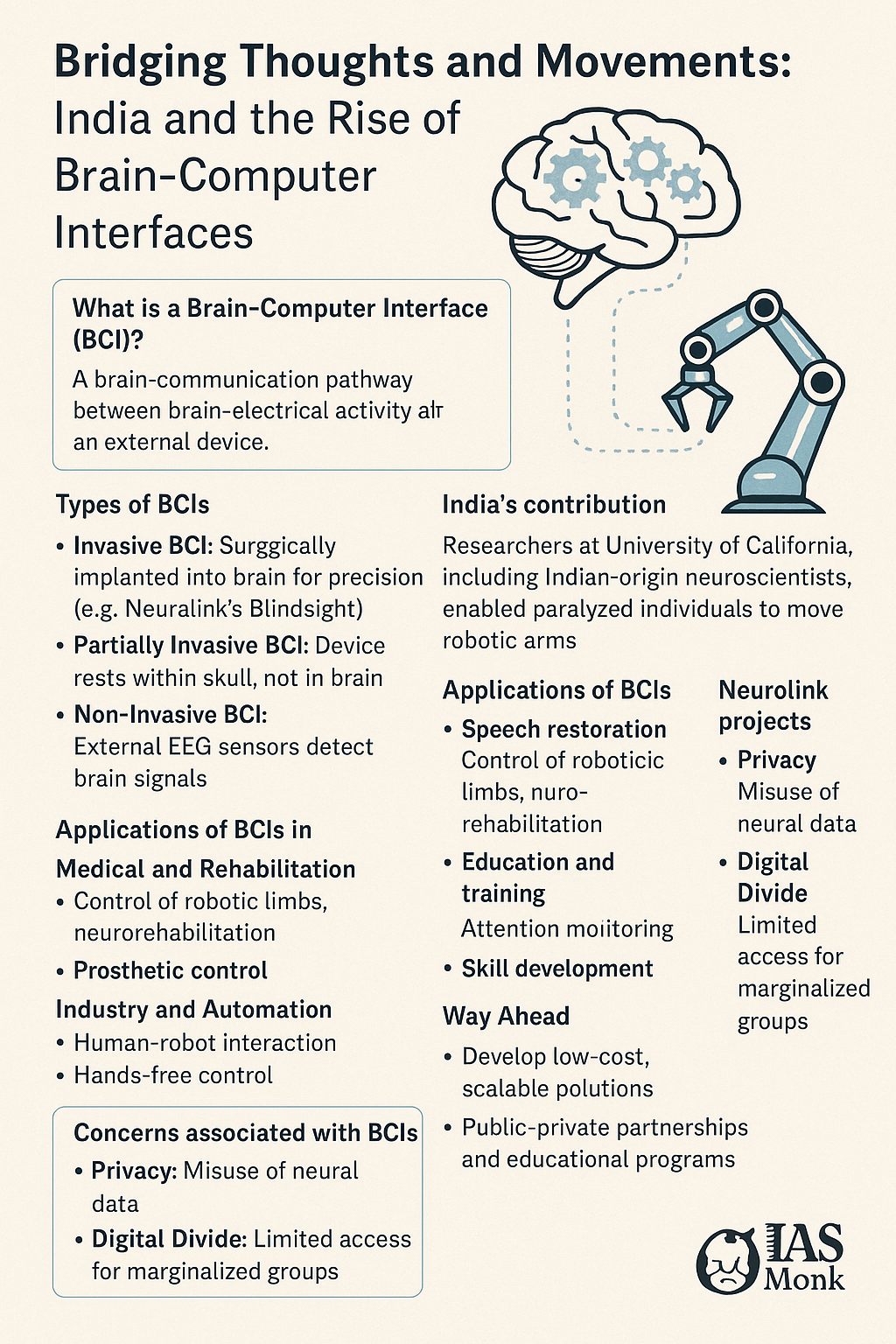
📅 May 3, 2025, Post 8: 🧠 Bridging Thoughts and Movements: India and the Rise of Brain-Computer Interfaces |Mains Essay Attached | Target IAS-26 MCQs Attached: A complete Package, Dear Aspirants!
🧠 Bridging Thoughts and Movements: India and the Rise of Brain-Computer Interfaces

NATIONAL HERO — PETAL 008
🗓️ May 3, 2025
📚 GS Paper 3 | Science & Technology – Recent Developments & Applications
Thematic Focus
• Brain-Computer Interface (BCI)
• Disability Innovation & Neurotechnology
• Neuralink & FDA Breakthrough Device
Intro Whisper
🌀 From the silence of paralysis to the hum of mind-controlled machines, a new era in neuro-innovation is unfolding — one where thought itself becomes motion.
Key Highlights
• What is a BCI?
A Brain-Computer Interface enables direct communication between a human brain and an external device, bypassing traditional muscular control. It decodes signals from the motor cortex and transforms them into robotic or digital commands.
• Categories of BCIs
- Invasive BCI – Implanted inside the brain; highly accurate (e.g. Neuralink’s Blindsight)
- Partially Invasive BCI – Inside the skull, but not in brain tissue
- Non-Invasive BCI – Uses EEG sensors; safer, more accessible
• Indian Contribution
University of California researchers, including Indian-origin neuroscientists, have decoded signals from the brain’s motor cortex to enable robotic arm movement in paralyzed individuals.
• Applications Across Fields
- Medical: Robotic limb control, speech recovery (Neuralink), neuro-rehabilitation
- Industry: Brain-guided robots for hazardous work
- Education: Real-time focus tracking
• Neuralink’s Speech & Vision Projects
- Speech Restoration: For ALS & cerebral palsy patients
- Blindsight Chip: Stimulates the visual cortex to restore vision
- FDA granted Breakthrough Device status to fast-track these innovations
• Challenges and Ethical Concerns
- Privacy: Brain data is deeply personal
- Mental Autonomy: Long-term effects on identity
- Digital Divide: Access to such tech may be unequal
• Way Forward
- Affordable BCIs via public-private innovation
- Training neuro-tech experts
- Policy and ethical frameworks for safe integration
GS Mains Paper Mapping
- GS Paper 3: Science & Tech – Developments & Applications
- GS Paper 2: Issues Relating to Health & Welfare
- Essay Paper: Ethics of AI & Future Human-Machine Relationships
A Thought Spark — by IAS Monk
“Isn’t it ironic? What we once feared as mind-reading machines may now become the whisper of hope for those whose bodies forgot how to speak.”
High Quality Mains Essay For Practice :
Word Limit 1000-1200
Brain-Computer Interfaces: Merging Thought with Technology for a New Human Era
In a world increasingly shaped by technological marvels, Brain-Computer Interfaces (BCIs) emerge as one of the most profound frontiers—blurring the boundary between human cognition and machine intelligence. Once the realm of science fiction, BCIs now stand at the cusp of revolutionizing not only medicine and mobility but also the very nature of communication and self-expression.
At its essence, a BCI is a direct communication bridge between the brain’s electrical signals and an external device. For individuals with paralysis or severe neurological disorders, this could mean the difference between isolation and autonomy. From enabling the movement of robotic limbs to restoring speech through brain-decoded impulses, these advances are not merely functional—they are deeply human.
India and the global community alike are watching closely as companies like Neuralink and institutions like the University of California translate research into reality. The implications are life-changing: ALS patients typing through thoughts, amputees commanding prosthetics with willpower, and individuals with speech impairments regaining their voice through neural patterns. These aren’t futuristic dreams anymore—they’re present-day milestones.
Yet, as we race forward, caution must accompany our ambition. Ethical dilemmas loom large: Who owns neural data? How do we protect the sovereignty of thought? Can the mind remain free when machines begin to interpret it? The digital divide could worsen if access to such innovations remains a privilege of the few. Moreover, the question of mental autonomy—the fear that prolonged machine-brain entanglement might alter identity—requires rigorous reflection.
In India, the transformative potential of BCIs lies in scalable, inclusive design. If adapted wisely, such technologies can uplift millions with disabilities, creating pathways to participation, productivity, and dignity. Through public-private partnerships, localized research ecosystems, and awareness-building, we can lead a BCI movement grounded in both innovation and empathy.
Ultimately, BCIs don’t just promise new tools—they offer a new paradigm. They challenge us to reimagine ability, redefine intelligence, and rediscover what it means to be human in the age of neural symbiosis. In listening to the silent language of the brain, we may finally give voice to those who have waited too long to be heard.
Target IAS-26: Daily MCQs : May 3, 2025
📌 Prelims Practice MCQs
Topic: 🧠 Brain-Computer Interfaces (BCIs) & Neuralink – MCQs
MCQ 1 — Type 1: How many statements are correct?
Question 1:
Which of the following statements about Brain-Computer Interfaces (BCIs) is/are correct?
1) BCIs allow direct communication between the human brain and external devices.
2) Non-invasive BCIs require surgical implantation into the brain.
3) Invasive BCIs typically offer more precise signal detection than non-invasive ones.
4) Neuralink’s “Blindsight” chip is aimed at restoring auditory perception.
Options:
A) Only 1 and 3
B) Only 2 and 4
C) All four
D) Only 1, 2 and 4
🌀 Didn’t get it? Click here (▸) for the Correct Answer & Explanation
✅ Correct Answer: A) Only 1 and 3
🧠 Explanation:
• 1) ✔️ Correct – BCIs enable communication between the brain and devices.
• 2) ✖️ Incorrect – Non-invasive BCIs use external sensors like EEG; they do not require surgery.
• 3) ✔️ Correct – Invasive BCIs are surgically implanted and provide high-resolution signals.
• 4) ✖️ Incorrect – “Blindsight” is for vision restoration, not auditory.
MCQ 2 — Type 4: Both, Neither-nor
Question 2:
With reference to Neuralink’s recent advancements, consider the following statements:
1) Neuralink’s chip can be used by patients to operate devices using thoughts alone.
2) Neuralink has received the FDA’s Breakthrough Device Designation for speech restoration technology.
Which of the above is/are correct?
A) Only 1
B) Only 2
C) Both 1 and 2
D) Neither 1 nor 2
🌀 Didn’t get it? Click here (▸) for the Correct Answer & Explanation
✅ Correct Answer: C) Both 1 and 2
🧠 Explanation:
1) ✔️ True – Neuralink aims for brain-controlled interaction with devices (cursor movement, etc.).
2) ✔️ True – The speech restoration brain chip has been awarded Breakthrough Device Designation.
















